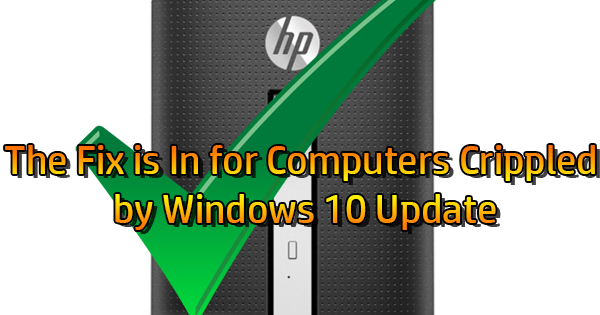
If you joined us for our previous post “Take a Break from Windows Update”, you know that my week totally sucked. HP computers were dropping like flies thanks to an ill-advised Windows 10 Update that rendered them inoperable via a WDF_Violation error. If you missed it, click here. Fortunately, things have looked up for those of us who were affected. HP has offered a solution to get their computers back up and running. Today we’ll tell you how to bring your computer back from the dead.
As a refresher, Windows released the KB4462919 update on October 10th. As Windows 10 makes it very difficult (if not impossible) to pass on critical updates, most computers downloaded and installed the update around that date. When the computer was restarted, the update would finish installing, and never allow the user to get to the Windows log in screen. You’d be greeted with a blue screen displaying a “WDF_Violation” error. System Restore would fail. Resetting Windows would fail. You name it, it didn’t work. From what I’ve read on the Internet, and we know that if it’s on the Internet it has to be true (sarcasm), computers of all manufacturers have been impacted. The businesses I service almost exclusively use HP computers. To HP’s credit, they identified that the Windows Update attempted to update their keyboard driver. Through my own research, I discovered that the crash was triggered by connecting a USB keyboard to an HP machine. An “old fashioned” keyboard with a purple PS/2 connector would work just fine on a computer that had already shown the WDF_Violation error. As soon as a USB keyboard was plugged in again, the computer would fail to start.
The solution to all of our problems (well, maybe not all of them) lies in Windows 10’s recovery tools, and the command prompt in particular. After the computer fails to start correctly three times, you can access the recovery or troubleshooting tools. You can save some time by booting to your Windows 10 installation disc. Don’t have one? Don’t worry. Read “When You’re Out of Options” for all the details on how to make your own. Insert the disc, and start the computer. Look for “Repair your computer” and “Advanced Options”. We need to open command prompt, so click on “Command Prompt”. When it opens, you’ll need to enter a series of commands. These commands differ depending on whether you have a 32-bit computer or a 64-bit P.C. In 2018 you most likely have a 64-bit device, so try entering this first (without the quotation marks): “dism /Image:C:\ /Remove-Driver /Driver:c:\Windows\System32\driverstore\FileRepository\hpqkbfiltr.inf_amd64_714aca0508a80e9a\HpqKbFiltr.inf” . Make sure there is a space between “Remove-Driver” and “/”. That tripped me up more than once. Press “ENTER” when you’re finished typing, and you’ll see that the driver has been successfully removed. If it doesn’t work right away (an error will be displayed on the screen), look over your typing VERY carefully because it’s easy to miss a letter or number. Type “exit”, press “ENTER”, and restart your computer, and you should be good to go. If that doesn’t work and you have an older 32-bit computer, type this instead (also without quotation marks): “dism /Image:C:\ /Remove-Driver /Driver: C:\Windows\System32\DriverStore\FileRepository\hpqkbfiltr.inf_x86_f1527018cecbb8c2\HpqKbFiltr.inf” . Perform the same steps as above. And cross your fingers.
Things were really looking bleak around here for a while. WDF_Violations are usually pretty difficult to fix. Thanks to a lot of hard work by a lot of people, the fix is finally in! I hope this works for you too as a perfectly healthy computer that you suddenly can’t access is a very helpless feeling. If you’re worried this is beyond your ability, please don’t hesitate to let us know and we’ll be happy to help.
